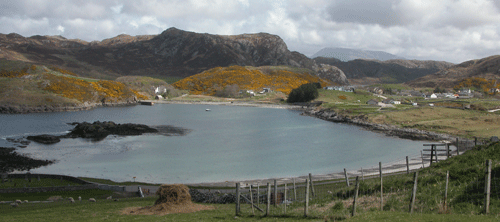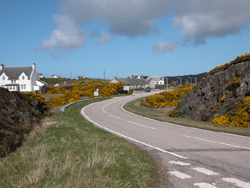
Mackay Country
Dùthaich Mhic Aoidh
An area in North-West Scotland of natural unspoiled beauty, rich in heritage & history
Scourie
The Crofting community, once a Mackay stronghold lies in the center of the parish of Eddrachillis. This is an area with good road connections in a locality dominated by the peaks of Fionaven, Arkle, Ben Stack, Quinag, Suilven., Canisp and Ben More Assynt

The village of Scourie lies on the west coast of Sutherland district in Highland Council Area, at the head of Scourie Bay, 5 miles (8 km) west of Laxford Bridge. The village is famed for the palm trees that grow in the garden of Scourie House, a consequence of the warming effects of the Gulf Stream. The village is a popular centre for walkers and anglers, whilst trips to the nearby island of Handa and the nature reserve there are popular summer excursions. Scourie is a popular staging post on the west coast and offers a shop, hotel and the camping and caravan site for visitors. By the entrance to the camp site is a lane that leads down to a slipway and a jetty, where until the Second World War all supplies for the area were delivered by steamship.
Coming to Scourie form the South and heading north, the main “coast” road steers inland only getting close as it crosses the Kylesku Bridge, and finds the sea at Badcall, just south of Scourie. Badcall is the home to the Eddrachillis Hotel, built in 1835 as the parish manse. After a few years a large fishing station was built on the bay. It is now used as a base for fish farming in Badcall Bay.
On the south side of the bay, accessible from the road leading to the cemetery, is a stretch of sand bounded by rocks. This offers views across the bay to Scourie itself and of the powerfully rocky landscape that makes up so much of this part of the area. Palm trees growing in the vicinity are claimed to be the most northerly in the world. The landscape around Scourie is one of innumerable small lochans.
Close by is the road that leads down to Scourie pier, at the east end of Scourie Bay. Shielded from the pier by trees is Scourie House, built for the Sutherland estate factor in 1846. Most of Scourie lies on the old road that appears opposite the Scourie Hotel, now by passed by the A894. Here is variety of charming cottages and crofts sheltering at the foot of the surrounding hills.

The name Scourie is from the Norse “Skaga” a copse and from the early Gaelic, a sheiling and lies in a hollow that was once a marshy loch. At Scourie the traveller is presented with a wonderful rocky bay stretching north west towards Handa Island. On the south side of the bay, accessible from the road leading to the cemetery, is a stretch of sand bounded by rocks. From here you gain some nice views across the bay to Scourie itself and of the intensely rocky landscape that makes up so much of this part of north west Sutherland. From the right spot on the far side of Scourie Bay, you can also see the top of Ben Stack appearing over the intervening landscape to the east.
South of Scourie is Scouriemore and the primary School.
.
At Scouriemore Headland from the beach car park this mostly unmarked route follows the coastline around the point back to the far end of the village. It is a geological site of Special Scientific Interest formed of the oldest rocks in Europe, with features such as “Scourie Dykes” evident – dark intrusions of molten igneous rock into much older formations (there is a good example behind the graveyard). Further round the coast is a site, which has some of the largest garnet clusters found. Apart from the rocks, there are outstanding views east across the Minch to Lewis and South to the Old Man of Stoer in Assynt. Although you may not see them this is an area where otters are very active and there are signs about. Beware for seals, cetaceans and seabirds. This walk has many shortcuts should you but it will reward you to walk to the cliffs at Mheall Deartj below, which are inaccessible caves.
As you enter Scourie, you pass on your left its camping and caravanning site. This well serviced site offers a superb location with pitches on a number of levels overlooking the bay. The facilities provided are modern and the site is popular with tourists.
From the campsite the main roads leads you past a petrol station and just beyond it is another welcome sight, the white-painted Scourie Hotel. This offers accommodation as well as food and drink for the passing visitor. It was built by the second Duke of Sutherland as a coaching inn and stands on the site of an old fortified house overlooking Scourie Bay. Close by is the road that leads down to Scourie pier, at the east end of Scourie Bay, shielded from the pier by trees is Scourie House, built for the Sutherland estate factor in 1846.
Most of Scourie lies on the old road that appears opposite the Scourie Hotel, now by passed by the A894. Here is variety of charming cottages and crofts sheltering at the foot of the surrounding hills.
From Scourie the road north actually heads only a little north of east, towards Laxford Bridge. Half way to Laxford Bridge is a turning on the left that leads to Foindle, Fanagmore and Tarbet, and from there to Handa Island. Handa Island is a Scottish Wildlife Trust bird sanctuary with spectacular sea cliffs and Stacks. and an abundance of bird life. Handa is separated from the mainland by the Sound of Handa





Most of Scourie lies on the old road that appears opposite the Scourie Hotel, now by passed by the A894. Here is variety of charming cottages and crofts sheltering at the foot of the surrounding hills.
“The village also claims to be the only one in the world where, depending on the season of the year, you can see Palm Trees, Red and Black Throated Divers and Highland Cattle, from the foreshore of the bay.”
1689 – General Hugh Mackay of Scourie, who had served with the Scots Brigade in Holland, is made Commander-in-Chief in Scotland by William, Prince of Orange; is defeated at Killiecrankie but wins the campaign against Claverhouse.
MACKAY, HUGH (c. 1640—1692), Scottish general, was the son of Hugh Mackay of Scourie, Sutherlandshire, and was born there about 1640. He entered Douglas’s (Dumbarton’s) regiment of the English army (now the Royal Scots) in 1660, accompanied it to France when it was lent by Charles II. to Louis XIV., and though succeeding, through the death of his two elder brothers, to his father’s estates, continued to serve abroad
In 1669 he was in the Venetian service at Candia, and in 1672 he was back with his old regiment, Dumbarton’s, in the French army, taking part under Turenne in the invasion of Holland. In 1673 he married Clara de Bie of Bommel in Gelderland. Through her influence he became, as Burnet says, “the most pious man that I ever knew in a military way,” and, convinced that he was fighting in an unjust cause, resigned his commission to take a captaincy in a Scottish regiment in the Dutch service. He had risen to the rank of major-general in 1685, when the Scots brigade was called to England to assist in the suppression of the Monmouth rebellion. Returning to Holland, Mackay was one of those officers who elected to stay with their men when James II., having again demanded the services of the Scots brigade, and having been met with a refusal, was permitted to invite the officers individually into his service. As major-general commanding the brigade, and also as a privy councillor of Scotland, Mackay was an important and influential person, and James chose to attribute the decision of most of the officers to Mackay’s instigation. ~
Soon after this event the Prince of Orange started on his expedition to England, Mackay’s division leading the invading corps, and in January 1688—89 Mackay was appointed majorgeneral commanding in chief in. Scotland. In this capacity he was called upon to deal with the formidable insurrection headed by Graham of Claverhouse, Viscount Dundee. In the battle of Killiecrankie Mackay was severely defeated, but Dundee was killed, and the English commander, displaying unexpected energy, subdued the Highlands in one summer. In 1690 he founded Fort William at Inverlochy, in 1691 he distinguished himself in the brilliant victory of Aughrim, and in 1692, with the rank of lieutenant-general, he commanded the British division of the allied army in Flanders. At the great battle of Steinkirk
Mackay’s division bore the brunt of the day unsupported and the general himself was killed.
Mackay was the inventor of the ring bayonet which soon came into general use, the idea of this being suggested to him by the failure of the plug-bayonet to stop the rush of the Highlanders at Killiecrankie. Many of his despatches and papers were published by the Baunatyne Club in 1883.